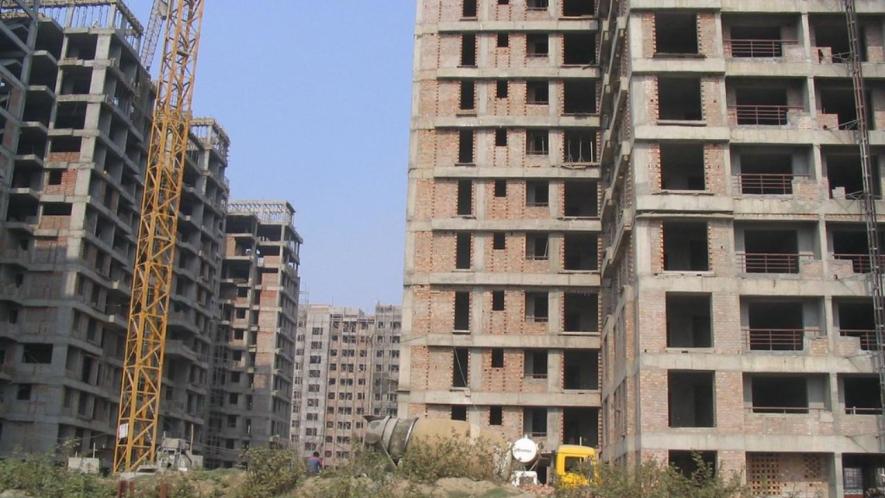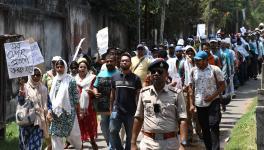Kolkata: Tilted Buildings, Crumbling Law, Endangered City

Representational Image. Image Courtesy: Flickr
Last year, the incidence of 12 bridge collapses in two weeks in Bihar might have been recorded in the Guinness Book, but this winter, the tilting of four successive buildings in a day in Kolkata may be a new record of infrastructure disaster. Just like serial killing, one after another, reinforced concrete high-rise buildings were seen tilting in Kolkata, a 345 year-old megacity, the capital of West Bengal.
None of those tilted structures are even a century old, but such technology-driven structures in their early age have lost the ability to stand upright due to construction defects. As a result, more than six million city dwellers are spending anxious hours with the fear of building collapse.
In the meantime, a tilted high-rise in ‘Baghajatin’ in South Kolkata collapsed like a house of cards in broad daylight. As a result, the fear of such tilted buildings has struck deeper into the minds of the general public across the city and suburbs. More so, because the majority of such tilted houses have been found to be
illegal construction, which has seen a rampant increase across.
Housing Security in Question
Over the past two decades, the pace of urbanisation has increased rapidly in the entire country. Two-thirds of the gross domestic product (GDP) of an ‘agro-based’ rural country is now being generated from urban areas. As a result, cities have become search engines for people’s improved income. In addition to increased income, improved education, health, housing, transportation, business, commerce and ancillary services are also attracting more and more people to cities. As a result, the city boundary is expanding to provide more housing for more people from the upper to the lower classes.
The city is also growing in height due to paucity of land in its peripheral areas. Hence, if a planned construction approach is not yet developed in an old historic, unplanned city like Kolkata, its ecological balance will face terrible disruption.
The city’s environment will be destroyed, the sustainability of people’s housing will be endangered with the threat of losing shelter in the city. Therefore, the issue of illegal construction is not only an issue of city law and order, but has a larger perspective with regard to the identity of its citizens.
Enforcement of Law
Not only Kolkata, every major city in the country has its own building rules. Despite that, illegal construction is increasing across the country not due to the lack of appropriate building rules but due to the lack of strict enforcement of those laws. According to constitutional provisions, municipal corporations are third-tier local governments, like the state or Central government.
These autonomous corporations are run by elected representatives and are accountable for urban governance by reinforcing the laws through their own administrative mechanism.
In West Bengal, since the past 15 years, the Trinamool Congress (TMC) has been ruling the Kolkata Municipal Corporation (KMC) as well as the state government. But in the context of sequential building failure, the city mayor, being the head of KMC, has disowned his responsibility and tried to put the blame on the earlier Left Front regime, though he failed to respond when asked about the database of illegal buildings built in the city in the past 40 years. In the absence of such a database, the issue of regime-based illegal construction, unsafe houses or weak structures cannot be addressed.
Tilted Governance
The primary responsibility to stop any illegal industry or services lies with the administration, but the state government and municipality have both failed miserably to stop illegal construction as an emerging industry.
The primary responsibility of municipal representatives is to play the role of watchman/woman in the municipal administration to protect citizens’ rights. But the growth of illegal construction across the city indicates a peaceful alliance of corporation councillors with promoters and developers, which has kept the municipal administration inactive against putting a stop to illegal construction.
The mayor of Kolkata has claimed that the tilting of the building essentially did not mean building collapse. But when the majority of the tilted structures were found illegal, then his assurance against one such building may raise questions about the intention of the mayor, Is he trying to hide the crime of illegal construction by diluting its dangerous aspect?
Illegal construction includes poor type of foundation, poor quality of concrete and steel in the load-bearing structure, violation of spacing between the foundations of two adjacent houses, construction of additional floor areas etc., to earn maximum profit. So, when such an illegal building starts to tilt, it exhibits a distress signal of the structure, which needs to be repaired with immediate effect with appropriate technology.
It may be noted that the repair of tilted structures is a very specialised technique that includes the safety and stability of adjacent buildings and structures too. Therefore, such repairs need to be done by suitable enlisted qualified vendors with prior intimation to the municipal administration to ensure the safety and security of the locality. The lack of such preparation of building repair has also raised concerns in the city.
Rules Without Enforcement
The primary goal of the administration is to establish the rule of law. But when the law of the ruling party is established, it undermines institutional responsibility. However, eventually, it is the municipal administration which will be held accountable if the building rules are not being implemented. A rule without its enforcement demonstrates lawlessness. So, when a government compromises with illegal construction by real estate promoters and developers in a service-oriented economy, the safety of citizens is most endangered.
Whether a building is in Kolkata or California, everything depends on the bearing capacity of the soil. The normal Kolkata subsoil exhibits a low bearing capacity on shallow foundations. Therefore, since ancient times, tall buildings have never been built in the city as it has soft soil. However, during the period of uncontrolled urbanisation, high-rise buildings are being built without proper soil investigation and foundation, which is causing the tilting of buildings in Kolkata.
Illegal Construction Changes Land Character
Illegal construction is closely linked with changes in the character of land. The land area in the city is characterised by its use pattern such as wetland, marshy land, forest land, agricultural land or land area for building etc. But in recent times, illegal construction, by filling up the city’s wetland and drainage channels, has become the rule of the day.
The Chief Minister has been calling for water storage and its recharging with the catchline ‘Jal Dhoro, Jol Boro’ (Catch the Water, Fill the Water). On the contrary, her party has been reportedly sponsoring promoters and developers who are filling up ponds and water bodies for illegal construction by manipulating law makers and police. Thus, the wetland areas being the kidneys of Kolkata are getting choked and filled up with soil in daylight in front of the police administration.
Recently, a survey of Kolkata city revealed that 270 ponds had been filled up in five wards of the Garden Reach-Metiaburuz area from 2004 to 2022. In this context, the growing damage to the ecosystem in Kolkata has emerged as a serious threat to the environment.
Alarmingly, in the past 20 years, the built-up area in Kolkata city and its suburbs has almost doubled. In addition, the green space in the city has decreased by 30% in the past 10 years. While the green cover has increased in the big cities of the country, the amount of green space in Ahmedabad has alarmingly decreased by 48% and Bengal scores second in that list.
Quake-Based Disaster
Last year, more than 50,000 people died in the earthquake in Turkey when concrete buildings collapsed. The majority of the collapsed houses were reportedly illegally built houses. Recently, various areas of Kolkata city have been identified as vulnerable to earthquakes. Based on micro-zonation, areas like
Newtown, Rajarhat, Mahishbathan, Kasba, Jadavpur, Behala, Park Street, Shobhabazar are on the list. But unfortunately, the rate of urbanisation and construction is also higher in these areas, raising the possible threats of building tilt or collapse during a moderate to high-intensity earthquake.
Also, the low bearing capacity of city soil may further decrease due to which foundation failure of buildings may get accelerated. Although the Municipal Act has some provision on exemptions for construction in the colony areas of the city, it is necessary to control the construction of high-rise buildings even there without checking the structural stability or the bearing capacity of the soil.
Therefore, from multiple viewpoints, it should be the primary responsibility of municipal administration to guarantee a safe building structure for its citizens, who pay the municipal taxes.
The writer is Professor, Department of Construction Engineering, Jadavpur University, Kolkata. The views are personal.
Get the latest reports & analysis with people's perspective on Protests, movements & deep analytical videos, discussions of the current affairs in your Telegram app. Subscribe to NewsClick's Telegram channel & get Real-Time updates on stories, as they get published on our website.
























